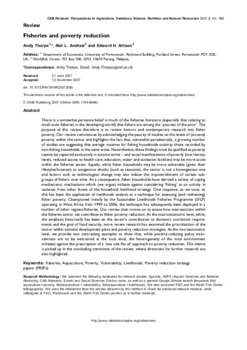Fisheries and poverty reduction

Citation
Thorpe, A.; Andrew, N.L.; Allison, E.H. (2007). Fisheries and poverty reduction. CAB Reviews: Perspectives in Agriculture, Veterinary Science, Nutrition and Natural Resources 2. no.085, 12 p.
The purpose of this review is to review historic and contemporary research into fisher poverty. Our review commences by acknowledging the paucity of studies on the levels of (income) poverty within the sector and highlights the fact that, somewhat paradoxically, a growing number of studies are suggesting that average incomes for fishing households outstrip those recorded by non-fishing households in the same areas. Nevertheless, these findings must be qualified as poverty cannot be captured exclusively in income terms – and social manifestations of poverty (low literacy levels, reduced access to health care, education, water and sanitation facilities) may be more acute within the fisheries sector. Equally, while fisher households may be more vulnerable (given their lifestyles/location) to exogenous shocks (such as tsunamis), the sector is not a homogenous one and factors such as technological change may also induce the impoverishment of certain subgroups of fishers over time. As a consequence, fisher households have derived a variety of coping mechanisms, mechanisms which (we argue) militate against considering ‘fishing’ as an activity in isolation from other facets of the household livelihood strategy. One response, as we note, to this has been the application of livelihoods analysis as a technique for assessing (and redressing) fisher poverty. Championed initially by the Sustainable Livelihoods Fisheries Programme (SFLP) operating in West Africa from 1999 to 2006, the technique has subsequently been deployed in a number of other regions/fisheries. Our review then moves on to assess how interventions within the fisheries sector can contribute to fisher poverty reduction. At the macroeconomic level, while the emphasis historically has been on the sector’s contribution to domestic nutritional requirements and the goal of food security, more recent research has examined the prioritization of the sector within national development plans and poverty reduction strategies. At the microeconomic level, we provide two contrasting examples to show that, while poverty-reducing policy interventions are to be welcomed at the local level, the heterogeneity of the local environment militates against the prescription of a ‘one size fits all’ approach to poverty reduction. This theme is picked up in the concluding comments of the review, where directions for further research are also highlighted.
Permalink
Date Available
Type
Publisher
Research Themes
Language